As a security camera user, I am often asked about the best ways to cover up or hide surveillance cameras.
Whether it’s to maintain privacy in certain areas of your home or business, or perhaps you don’t want others to know they are being recorded, there are several creative and effective methods for concealing a camera.
In this article, we will explore 8 different ways how to cover a security camera that can help keep them hidden from view.
From using camouflage covers and fake plants to installing discreet wall mounts and utilizing smart home technology, these tips and tricks will ensure that your surveillance system remains covert while providing valuable peace of mind.
So, Let’s start.
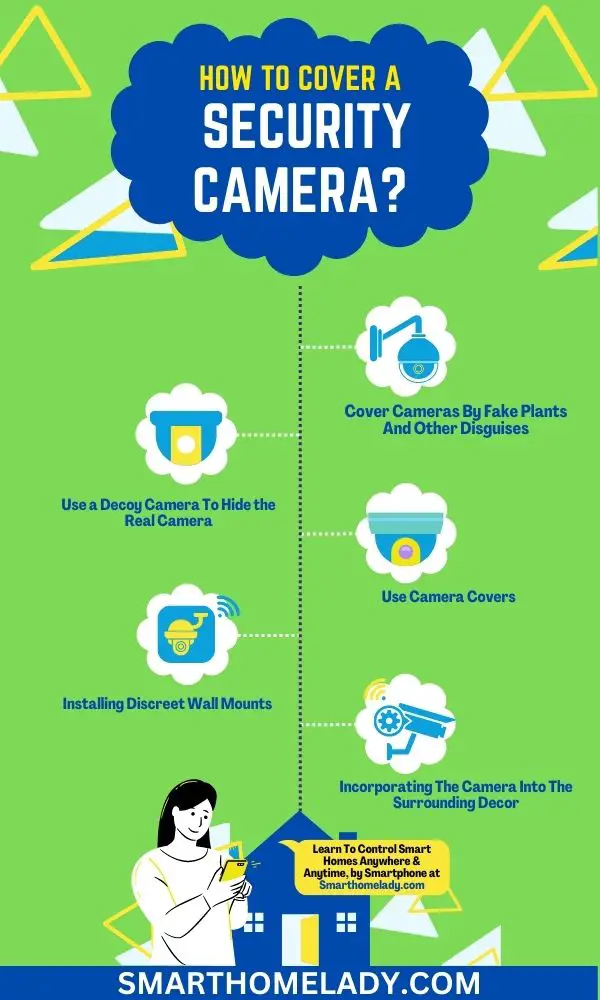
Contents
- 1 8 Ways On How To Cover A Security Camera?
- 1.1 1. Use Camera Covers For A Security Camera
- 1.2 2. Cover Cameras By Fake Plants And Other Disguises
- 1.3 3. Installing Discreet Wall Mounts to Cover Security Cameras
- 1.4 4. Painting The Camera To Cover It
- 1.5 5. Using Mirrors Or Other Reflective Surfaces
- 1.6 6. Incorporating The Camera Into The Surrounding Decor
- 1.7 7. Use a Decoy Camera To Hide the Real Camera
- 1.8 8. Use a Privacy Screen
- 2 2 Tips For Maintaining Camera Performance While Covered
- 3 Why Cover A Security Camera? 6 Reasons
- 4 Legalities Of Covering A Security Camera
- 5 How do you cover an outdoor security camera?
- 6 How do I secretly block security cameras?
- 7 How do you mask a security camera?
- 8 Conclusion
8 Ways On How To Cover A Security Camera?
Covering security cameras is not recommended as it can compromise the safety and security of the property.
However, if you must cover them for privacy or other reasons, here are some ways you could do it:
1. Use Camera Covers For A Security Camera
Camouflage covers are a popular choice for covering security cameras. However, alternative options can be just as effective in hiding the camera from view.
One option is using DIY camera covers made from cardboard or foam board materials. These covers can be painted or decorated to blend in with their surroundings, and they are inexpensive and easy to make.
Another alternative is to use weatherproof housings designed specifically for security cameras. These housings come in various colors and patterns, including wood grain and stone finishes, which allow them to blend seamlessly into outdoor settings.
Suggested Readings
- Beginners Guide To Security Cameras
- Do Security Cameras Have To Be Visible?
- How To Prevent Blink Cameras From Being Stolen?
- How Do I Keep My Security Camera From Being Stolen?
- How To Protect CCTV Camera From Rain?
2. Cover Cameras By Fake Plants And Other Disguises
Camouflage covers may not always be the best solution for covering security cameras. While they can blend in with their surroundings, sticking out like a sore thumb is not uncommon. After all, how often do you see random objects hanging from your neighbor’s house?
If you’re looking for something unique, consider using fake plants and disguises to conceal your security camera.
For example, you could mount the camera inside a birdhouse outdoor lights or attach it to a faux rock.
While these options may require more effort than simply using a camouflage cover, they offer greater flexibility when it comes to customization and creativity.
Each of these items has its own unique pros and cons when it comes to hiding your security camera.
For example, a birdhouse might look natural but could obstruct your camera’s view. On the other hand, an outdoor light could provide additional lighting at night while disguising your camera.
Choosing the right disguise for your security camera will ultimately depend on your specific needs and preferences.
It’s important to weigh each option’s potential benefits and drawbacks before making a decision that works best for you.
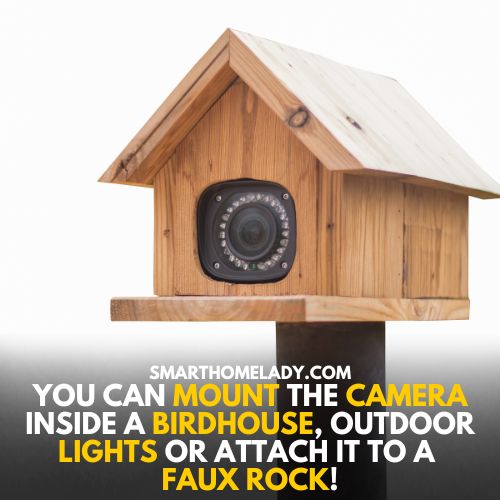
Suggested Readings
- Can Security Cameras Be Stolen?
- How To Clean Dome Security Cameras?
- Can Security Cameras Work Without Electricity?
- What Determines How Far A Camera Can See?
- How Do You Clean Security Cameras?
3. Installing Discreet Wall Mounts to Cover Security Cameras
Discreet wall mounts are an excellent solution to cover your security cameras. Discreet wall mounts come in various designs and materials that blend seamlessly into their surroundings, making them practically invisible.
They offer several benefits, including easy installation and flexibility when positioning your camera.
With proper planning and execution, they can be installed quickly with minimal disruption to your property’s appearance.
To install a discreet wall mount correctly, begin by;
- Selecting the right location for your camera based on its field of view and coverage area.
- Once you have determined the ideal position for your camera, drill pilot holes where the screws will go before attaching the mount securely to the surface using screws or anchors.
- Remember to ensure that all cables are neatly tucked away behind the wall mount for a clean finish.
With this knowledge in mind, installing discreet wall mounts should now be a breeze. A well-installed discreet wall mount will provide superior camouflage while allowing unrestricted surveillance of your property.
4. Painting The Camera To Cover It
Cameras are integral to any security system, but sometimes you may want to keep them hidden from plain sight. Painting your camera is one way to achieve this goal.
With a few simple steps, you can make your camera blend in with its surroundings and go unnoticed by potential intruders.
Painting the camera has several pros and cons that should be considered before carrying out the task.
| Pros | Cons |
|---|---|
| Makes the camera less noticeable | Improper painting can damage the device |
| Can help blend the camera in with its surroundings | Painting may interfere with the camera’s functionality |
| Provides a way to customize the appearance of the camera | May not be allowed by building or security regulations |
| May deter potential vandals or thieves | May require additional maintenance to upkeep the appearance |
| Can be a cost-effective solution compared to purchasing new cameras | Paint may chip or fade over time, requiring touch-ups or repainting |
If you decide to paint your camera, here are three things you need to know:
- Use a non-reflective color: A glossy finish will reflect light and draw attention to the device.
- Avoid covering important parts: Covering up lenses or other essential components could lead to decreased image quality or complete failure of the device.
- Be mindful of weather conditions: Extreme heat or cold temperatures can cause problems for painted cameras.
There are risks and benefits associated with every decision regarding your security system. By weighing these factors carefully, you’ll ensure that your efforts don’t backfire on you later on down the road.
Suggested Readings
- Do Home Security Cameras Use A lot Of Electricity?
- Security Cameras That Work When Power Goes Out
- Can Security Cameras See In The Dark?
- Can Security Cameras Be Jammed?
- Can You Use Any DVR With Security Cameras?
5. Using Mirrors Or Other Reflective Surfaces
Mirrors and other reflective surfaces can be an effective way to cover a security camera. By placing the mirror strategically, you can reflect the camera’s view away from its intended target. This DIY option is affordable and easy to implement.
One thing to keep in mind when using this method is that it may not work in all situations.
For example, if the camera has a wide-angle lens, it may capture images that are outside of the mirrored area.
Additionally, mirrors need to be cleaned regularly so they don’t become dirty or foggy, which could compromise their effectiveness.
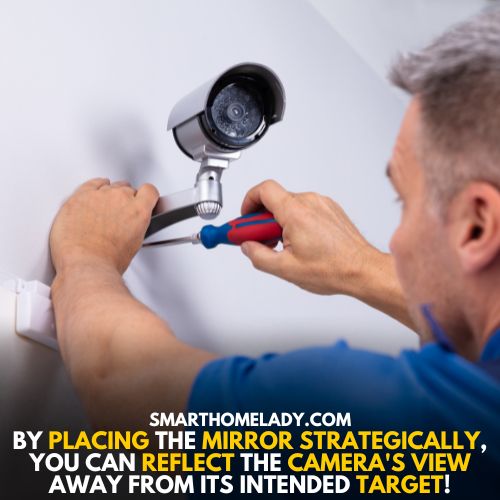
If you’re unsure how to properly use mirrors or other reflective surfaces to cover your security camera, consider hiring a professional installation service.
A skilled technician will know exactly where and how to place the mirrors for maximum effect. They can also recommend alternative solutions if this method isn’t right for your situation.
6. Incorporating The Camera Into The Surrounding Decor
Incorporating security cameras into your home’s decor can be done in various ways, depending on your personal style and preferences.
For example, you could choose a camera that resembles a clock or picture frame, which can easily blend in with the rest of your room’s decorations.
Another idea is installing cameras inside decorative light fixtures or bookshelves for concealment.
When it comes to concealing security cameras in a niche or alcove, there are several creative approaches one can take. You might try installing an artificial plant or flower arrangement around the camera lens, making it look like just another part of your flora display.
Alternatively, if you have built-in shelves or cabinets on your walls, you could place small cameras among books and knick-knacks so they blend seamlessly into their surroundings.
By getting creative with these ideas and others like them, you’ll keep your home secure and add unique touches to its overall aesthetic appeal.
7. Use a Decoy Camera To Hide the Real Camera
A decoy camera can be an effective way to deter criminals from targeting your property. Decoy cameras are designed to look like real cameras, but they don’t actually function as security devices.
They are easy to install and are usually much cheaper than real security cameras. Decoy cameras can be mounted on walls or ceilings, and they often come with flashing LED lights to give the impression that they are recording.
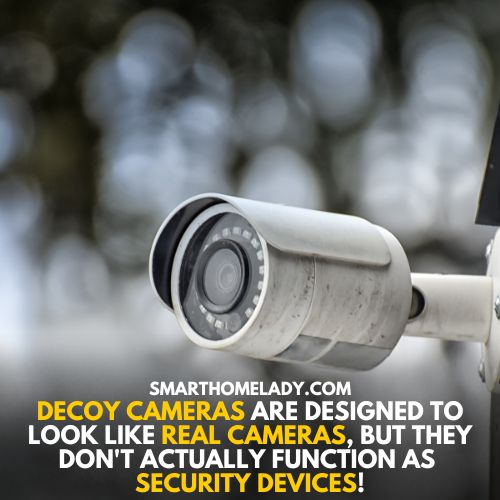
However, it’s important to note that decoy cameras are not a substitute for real security cameras.
They may deter some criminals, but they won’t capture any footage or provide real property protection.
8. Use a Privacy Screen
A privacy screen is a physical barrier that can block a security camera’s view. These screens are typically made from materials like vinyl or mesh and can be attached directly to the camera or mounted in front of it.
Privacy screens are often used to protect the privacy of individuals who are being recorded by security cameras. They can also be used to prevent criminals from seeing where a camera is pointed.
However, privacy screens can also obscure the view of the camera, making it difficult to capture clear footage. Additionally, they can be unsightly and may draw attention to the camera’s location.
Before using a privacy screen, it’s important to consider the potential drawbacks and weigh them against the benefits.
If privacy is a concern, a privacy screen may be a good option, but if clear footage is a priority, it may not be the best solution.
2 Tips For Maintaining Camera Performance While Covered
Ironically, it seems that the best way to maintain camera performance while covering it is by not actually covering it at all.
However, in certain situations where complete coverage is necessary for security reasons, there are ways to ensure your cameras stay functional and effective.
- Firstly, consider weatherproofing your camera before covering it. This can be done by purchasing a cover specifically designed for your camera model or using waterproof sealant on any openings. Otherwise, moisture may seep into the camera and cause irreversible damage.
- Secondly, glare can also pose a problem when covering cameras. To prevent this issue, try placing an anti-glare film over the lens or angling the camera slightly downwards so that sunlight doesn’t reflect directly onto the lens.
By following these tips for weatherproofing cameras and preventing glare on covered cameras, you’ll be able to keep your surveillance system functioning optimally, even with obstructions in place.
Remember that regular maintenance checks should still be conducted to ensure everything continues to run smoothly.
Why Cover A Security Camera? 6 Reasons
Covering security cameras has become a controversial topic in recent times. There are varying reasons why people choose to hide their cameras, but it’s important to consider the pros and cons before taking any action.
| Reasons to Cover Security Cameras | Pros | Cons |
|---|---|---|
| Privacy concerns | Provides a sense of comfort and security | May miss out on important footage |
| Aesthetics | Improves the appearance of property | May not deter criminals |
| Preventing hacking | Protects against potential hacking attempts | May hinder camera functionality |
| Avoiding legal issues | Protects against potential legal consequences | May miss out on important footage that could help solve crimes or identify intruders. |
| Saving energy | Reduces energy consumption | May compromise security |
| Shielding from weather | Protects camera from weather damage | May hinder camera functionality |
In conclusion, there are various reasons why someone may choose to cover their security camera. It’s important to weigh the pros and cons before making any decisions, as it could impact the effectiveness of your surveillance system.
Legalities Of Covering A Security Camera
Before deciding to cover a security camera, it is important to consider the legalities involved. While there are situations where covering a camera may be necessary for privacy reasons or protection against vandalism, doing so without proper authorization can have serious consequences.
The pros and cons of covering a security camera must be weighed carefully. On the one hand, covering a camera can provide peace of mind for those who feel uncomfortable with constant surveillance.
It can also prevent potential intruders from knowing where cameras are located. On the other hand, covering a camera could lead to missed footage that could help solve crimes or protect property.
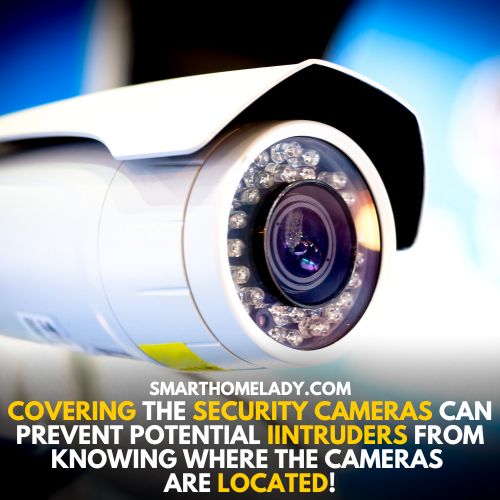
It’s important to note that there are legal ramifications associated with covering a security camera without permission.
In most cases, tampering with or obstructing a security camera is considered illegal and can result in fines or even criminal charges. Before deciding to cover your security cameras, consult with local laws and regulations to ensure you stay on the right side of the law.
| Pros | Cons |
|---|---|
| Increased Privacy | Missed Footage |
| Protection Against Vandalism | Potential Legal Consequences |
| Prevents Intruders From Identifying Camera Locations | Decreased Security Coverage |
In considering whether to cover a security camera, weighing the benefits and drawbacks is essential. Additionally, being aware of the legal implications surrounding such actions is crucial.
Understanding these factors will allow you to make an informed decision regarding how best to approach securing your property.
Suggested Readings
- Do You Need A License To Install Security Camera?
- Is It Illegal To Tamper With Security Cameras?
- Can We Use CCTV Camera Without DVR?
- Can I Use Xfinity Security Camera Without Service?
- Do Security Cameras Have To Be Visible?
Frequently Asked Questions FAQs
How do you cover an outdoor security camera?
Covering an outdoor security camera can be done in several ways. One option is to use weatherproof camera housing, which provides protection from rain, snow, and other elements.
Another option is to use camouflage or decorative covers that blend in with the surroundings.
Additionally, strategically placing the camera can provide some natural coverage, such as behind a tree or shrub. It is important to ensure that the camera lens is not obstructed and that it still has a clear view of the area being monitored.
How do I secretly block security cameras?
I strongly advise against blocking or tampering with security cameras as it is illegal and could result in serious consequences. So, here I won’t recommend you any method.
Moreover, security cameras are installed to ensure safety and security, and blocking them could put you and others in danger.
Instead, if you have concerns about being recorded, you can speak to the property owner or manager to address your concerns.
How do you mask a security camera?
One way to mask a security camera is by blending camouflage netting or foliage into its surroundings. This can make the camera less noticeable and deter potential intruders from attempting to tamper with it.
However, ensuring the camera’s view is not obstructed is important, as this could compromise its effectiveness.
Conclusion
So, I’ve discussed 8 different ways to cover your security camera here. Whether you want to blend in with its surroundings or make it less noticeable, these methods can help keep unwanted eyes from prying into your private life.
But remember, covering a security camera comes with risks and potential downsides. You may be violating laws or regulations, compromising the quality of the footage captured by the camera.
It’s important to weigh these factors carefully before deciding how to protect yourself and your property best.


